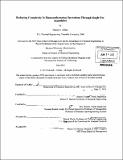Reducing complexity In biomanufacturing operations through single-use assemblies
Author(s)
Alfano, Edward J. (Edward James)
DownloadFull printable version (8.371Mb)
Other Contributors
Leaders for Global Operations Program.
Advisor
Roy Welsch and Charles Cooney.
Terms of use
Metadata
Show full item recordAbstract
Novartis Vaccines and Diagnostics operates a centralized equipment cleaning and preparation suite at a vaccine production facility in Marburg, Germany. The ~100 pieces of multi-use stainless steel, glass, and plastic equipment prepared at this centralized pretreatment suite all need to be disassembled, cleaned, reassembled, sterilized, shipped, and tracked. This highly complex cycle is problematic because of the coordination cost, possibility of assembly errors, and lack of operational flexibility. Additionally, the multi-use assemblies were designed as long as 20 years ago, and newer, more reliable alternatives exist. The goal of this project is to evaluate the hypothesis that replacing multi-use assemblies with single-use assemblies will reduce production risk and costs of goods sold of vaccines by reducing operational complexity. To understand the impact of adopting single-use assemblies, the one-time cost of switching (e.g. regulatory filings, validation studies, operational costs) are weighted against the potential for operational savings and risk reduction or transfer to vendors. The current-state variable costs and risks are evaluated with a cost model that accounts for variable equipment cost, operator cost, autoclave cost, and washer costs. Future state variable costs are determined through a request for proposal ("RFP") process with vendors. Novartis Vaccines and Diagnostics had previously conducted failure mode and effect analyses ("FMEA's"), and the critical and potentially critical risks affected by adopting single-use assemblies were reassessed. It is possible to reduce the complexity of pretreatment operations with single-use assemblies. Adopting the four of the assemblies studied in this project would reduce the number of components processed in a year by 40% and the number of unique components by 10%. Many critical or potentially critical risks, such as labeling, assembly, sterilization, transportation, and storage of assemblies will be transferred to third-party vendors. Because these vendors specialize in the production of single-use assemblies, they can invest in more costly capital equipment and processes such as higher class clean rooms and gamma sterilization. Some single-use assemblies will have a lower variable operating cost, while others will increase operating costs. Thus, new assemblies fall into three categories in a decision making framework: 1) Reduced risk and cost, 2) Pay for risk reduction, and 3) Continue with current state. Assemblies in categories 1 and 2 should be modernized from multi-use to single-use, while assemblies in category 3 should remain multi-use.
Description
Thesis (M.B.A.)--Massachusetts Institute of Technology, Sloan School of Management; and, (S.M.)--Massachusetts Institute of Technology, Dept. of Chemical Engineering; in conjunction with the Leaders for Global Operations Program at MIT, 2012. Cataloged from PDF version of thesis. Includes bibliographical references (p. 57-58).
Date issued
2012Department
Leaders for Global Operations Program at MIT; Massachusetts Institute of Technology. Department of Chemical Engineering; Sloan School of ManagementPublisher
Massachusetts Institute of Technology
Keywords
Sloan School of Management., Chemical Engineering., Leaders for Global Operations Program.